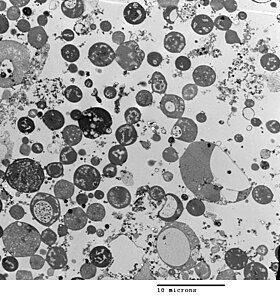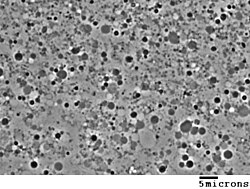L-form bacteria
L-form bacteria, also known as L-phase bacteria, L-phase variants or cell wall-deficient bacteria (CWDB), are growth forms derived from different
Discovery and early studies
L-form bacteria were first isolated in 1935 by
She first interpreted these growth forms as symbionts related to pleuropneumonia-like organisms (PPLOs, later commonly called mycoplasmas).[3] Mycoplasmas (now in scientific classification called Mollicutes), parasitic or saprotrophic species of bacteria, also lack a cell wall (peptidoglycan/murein is absent).[4][5] Morphologically, they resemble L-form bacteria. Therefore, mycoplasmas formerly were sometimes considered stable L-forms or, because of their small size, even viruses, but phylogenetic analysis has identified them as bacteria that have lost their cell walls in the course of evolution.[6] Both, mycoplasmas and L-form bacteria are resistant against penicillin.
After the discovery of PPLOs (mycoplasmas/Mollicutes) and L-form bacteria, their mode of reproduction (proliferation) became a major subject of discussion. In 1954, using phase-contrast microscopy, continual observations of live cells have shown that L-form bacteria (previously also called L-phase bacteria) and pleuropneumonia-like organisms (PPLOs, now mycoplasmas/Mollicutes) ) do not proliferate by binary fission, but by a uni- or multi-polar budding mechanism. Microphotograph series of growing microcultures of different strains of L-form bacteria, PPLOs and, as a control, a Micrococcus species (dividing by binary fission) have been presented.[3] Additionally, electron microscopic studies have been performed.[7]
Appearance and cell division

Although L-forms can develop from
The cell wall is important for

Generation in cultures
L-forms can be generated in the laboratory from many bacterial species that usually have cell walls, such as
Some studies have identified mutations that occur, as these strains are derived from normal bacteria.[1][2] One such point mutation D92E is in an enzyme yqiD/ispA (P54383) involved in the mevalonate pathway of lipid metabolism that increased the frequency of L-form formation 1,000-fold.[1] The reason for this effect is not known, but it is presumed that the increase is related to this enzyme's role in making a lipid important in peptidoglycan synthesis.
Another methodology of induction relies on
Significance and applications
Some publications have suggested that L-form bacteria might cause diseases in humans,
L-form bacteria may be useful in research on early forms of life, and in
L-form bacteria are seen as a persister cells, and a source of recurrent infection that has become of medical interest.[26]
See also
- Mycoplasmataceae—lack peptidoglycan but supplement their membranes with sterols for stability.
- Protoplast
- Spheroplast
- Ultramicrobacteria
References
- ^ S2CID 4413852.
- ^ PMID 17586646.
- ^ S2CID 21257985.
- PMID 9841667.
- ^
- PMID 6928642.
- S2CID 45546531.
- PMID 4631836.
- PMID 1905284.
- PMID 19706420.
- PMID 17090676.
- PMID 8501224.
- PMID 11018275.
- S2CID 24781904. Archived from the original(PDF) on 24 August 2009.
- S2CID 9863534.
- PMID 7399704.
- PMID 7287189.
- S2CID 1295920.
- PMID 16304175.
- PMID 31558767.
- OCLC 246350676.
- S2CID 23295806.
- PMID 9821280.
- PMID 9835575.
- S2CID 9923116.
- PMID 37082179.
Further reading
- ISBN 978-0-201-10162-1.
- Mattman, Lida H. (2001). Cell wall deficient forms: stealth pathogens. Boca Raton: CRC. ISBN 978-0-8493-8767-8.
External links
- Errington Group at Newcastle University
- Scientists explore new window on the origins of life 2009 Newcastle University press release
